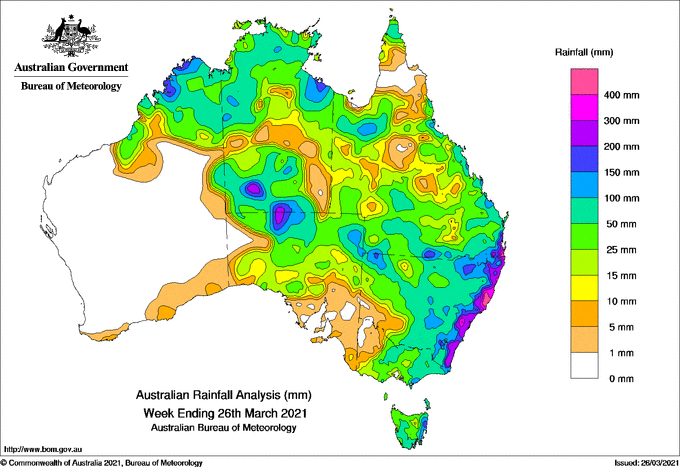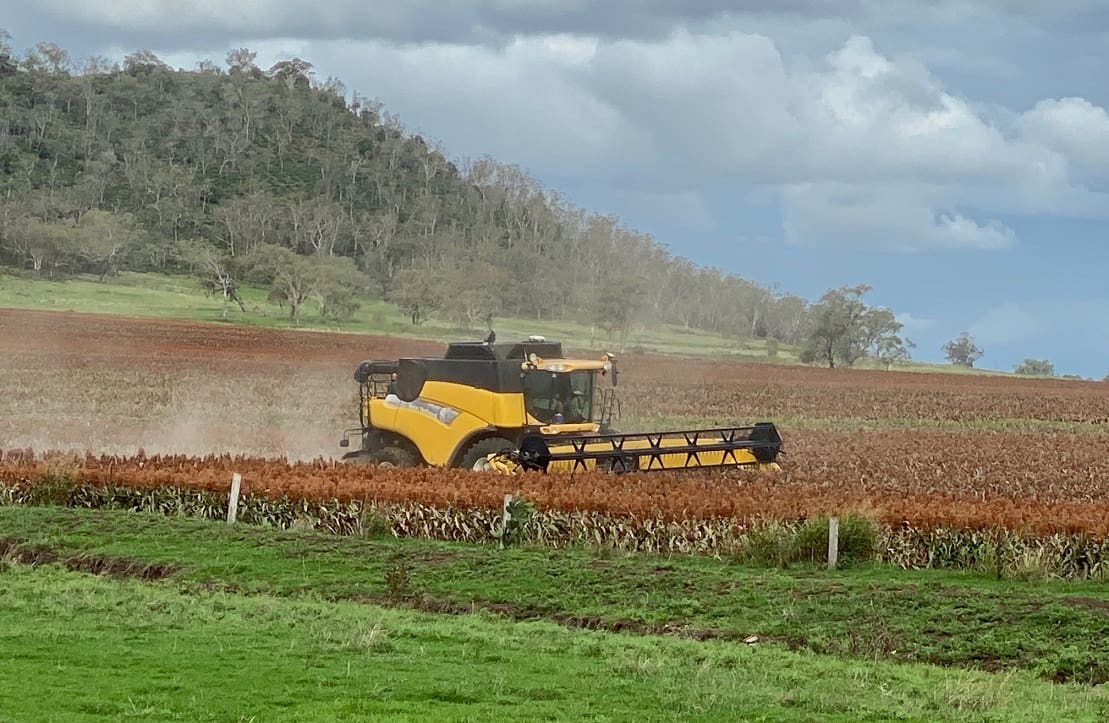
(Photo: Goldstar Commodities)
WIDESPREAD heavy rains throughout New South Wales and Queensland over the past week led to major flooding in coastal areas, but were generally welcomed by broadacre crop producers in inland regions which received up to 200 millimetres.
The rain topped up subsoil moisture levels for the forthcoming winter crop and saved some ailing summer crops, but caused waterlogging and sprouting issues for some summer crops nearing harvest.
Coastal regions bore the brunt of the heavy rains and flooding with totals for the week along the coast from Brisbane to the NSW-Victoria border reaching 200-400mm.
Despite the deluge, soybean crops on the NSW far north coast largely made it through relatively unscathed.
Norco manager at Casino, Robin Harley, said there had been no real impact on the region’s soybean crops which were approaching maturity.
“The beans that are on beds are okay, but anybody who didn’t have their beans on beds will have them a little bit waterlogged. But once beans get to the two-foot (0.6-metre) stage they are pretty foolproof, unless they are sitting in water for any length of time,” he said.
“The big concern for anybody who has beans in at the moment is they just want it to dry out enough in the next month or six weeks so they can harvest them.”

Subsoil moisture top up for NSW
In north west NSW, AMPS Agribusiness consulting agronomist at Moree, Tony Lockrey, said the rain had topped up subsoil moisture levels throughout the region, but had caused waterlogging issues for some summer crops.

Tony Lockrey
“There is some sorghum that is ripe and unharvested that will be a ‘problem child’. We will lose grain quality,” he said.
“There are late mungbeans that have some black pods on them. Some of those will split, but most of the pods are still green. As long as they don’t get severely waterlogged they will come through.
“There is some very late sorghum double-cropped that is still green, so it will be fine. The bulk of the sorghum was early and has been taken off.”
Mixed bag for Queensland
In Queensland, AgForce grains president, Brendan Taylor, said the rains had been “bitter sweet”, causing waterlogging and sprouting issues for some summer crops but providing much-needed subsoil moisture for finishing later-sown crops and the forthcoming winter crop planting.
Mr Taylor said good falls in Central Queensland had increased storage levels in Fairbairn Dam which would be very significant for irrigators.
In southern Queensland and the Darling Downs, he said substantial falls had left the region in a much better situation than it was two weeks ago.
“It has certainly rescued a lot of the summer crops that were teetering on the edge of being not much good. It is not going to increase the yield dramatically but it should increase grain quality and avoid screenings,” he said.
“A lot of crops of sorghum were quite mature before the rain and had done it hard to get to that point. It should hopefully increase plant stability and avoid lodging.”
On the down side, Mr Taylor said the heavy rains had created some sad stories for some summer crop producers.
“There were pockets east of Dalby that were being harvested when it started to rain. There are reports of sprouting in sorghum and mungbeans. Beans in particular don’t like a lot of rain on them,” he said.
“Some crops will be potentially downgraded because of the rain, but it has certainly given everyone a much brighter outlook for the coming winter season which is only a month away from planting. Before the rainfall events a lot of places had very little subsoil moisture.
“Here we had basically zero and we have had 100 to 150mm in the last couple of weeks and very little runoff. It is all in the soil where we need it.
“The fact we have a good moisture profile and, being March, the moisture should hold through until late April-May without any more rain, particularly in the heavy soils. There should be no deep, moisture-seeking planting. It will hopefully be a very conventional plant.”
Mr Taylor said one of the challenges ahead for growers was the delay to the summer crop harvest due to the rain that was likely to run it into the same period as winter crop planting.
“It doesn’t happen often but there will likely be sorghum coming off at the same time as barley or wheat are going in,” he said.

Sorghum growers on the Darling Downs rushed to take off as much of their crops as they could before the big rains came last week.
Mungbeans take a hit
Northern region extension agronomist, Paul McIntosh, said the heavy rains would have an adverse effect on mungbean crops nearing maturity.
“They’ll be in a bit of trouble. We didn’t want all this rainy weather on the mungbean crop. It is starting to sprout in the head and will be severely downgraded,” he said.
Mr McIntosh said the other thing happening with mungbeans was that there was a second crop emerging under the established crops.
“That may be a saviour for some paddocks because we may be able to let the first crop go and let the second crop come on and harvest it. But that will be on a paddock-by-paddock basis. There will be a lot of people scratching their heads about how they handle their paddocks after such a lot of rain. The first crop will be severely impacted unfavourably by the last week of very rainy weather,” he said.
Mr McIntosh said the rain would spark an outbreak of weeds, including those with herbicide resistance issues such as feathertop Rhodes grass, sow thistle and barnyard grass that would be especially hard to control.
“There may be more mechanical weeding or a lot more Weedit spraying to control these large weeds that may get out of control,” he said.
Water bonus for cotton
Cotton Australia chief executive officer, Adam Kay, said while the rain had caused some damage to cotton crops and potential loss of yield from boll rot, overall it had brought smiles to the faces of many growers.

Adam Kay
“There have been isolated patches of crop loss, but most growers have been able to get the water off their crops. We think there will be a little bit of boll rot in some of those areas that might reduce yields by 5 to 10 per cent,” he said.
However, with picking underway in Central Queensland and soon to move southwards, Mr Kay said the rain damage wouldn’t be significant enough for Cotton Australia to change its estimate for this season’s national crop of 2.6 million bales.
And it has raised the prospects for the next crop.
“If we start to do the numbers for next year, it is already looking like 3.0 to 3.5 million bales will be possible with the rain that has fallen in a lot of the growing areas,” he said.
Fodder crops ready to go in
The rain in the mixed farming areas is likely to prompt a surge in fodder crop sowings once farmers can get back onto their paddocks.
McGregor Gourley agronomist at Inverell in northern NSW, Alice Jorgenson, said there hadn’t been a lot of oats go in prior to the rain, but with plenty of time left for sowing producers were likely to get going again once they had completed their paddock preparation and weed spraying programs.
Ms Jorgenson said there was plenty of retained seed from last year when there was a good harvest.
Across the border in southern Queensland, Killarney Coop produce manager, Craig Thompson, said there had only been around 400 hectares of oats sown in the district prior to the rain, “but that is nothing to what will be put in”.
“Everything is ready to go. There is still plenty of time. Our best time for oats is April or May. There will be people planting right through to June,” he said.
“We needed rain but now we need fine weather. We could do with a month of fine weather now.”
Grain Central: Get our free cropping news straight to your inbox – Click here

HAVE YOUR SAY